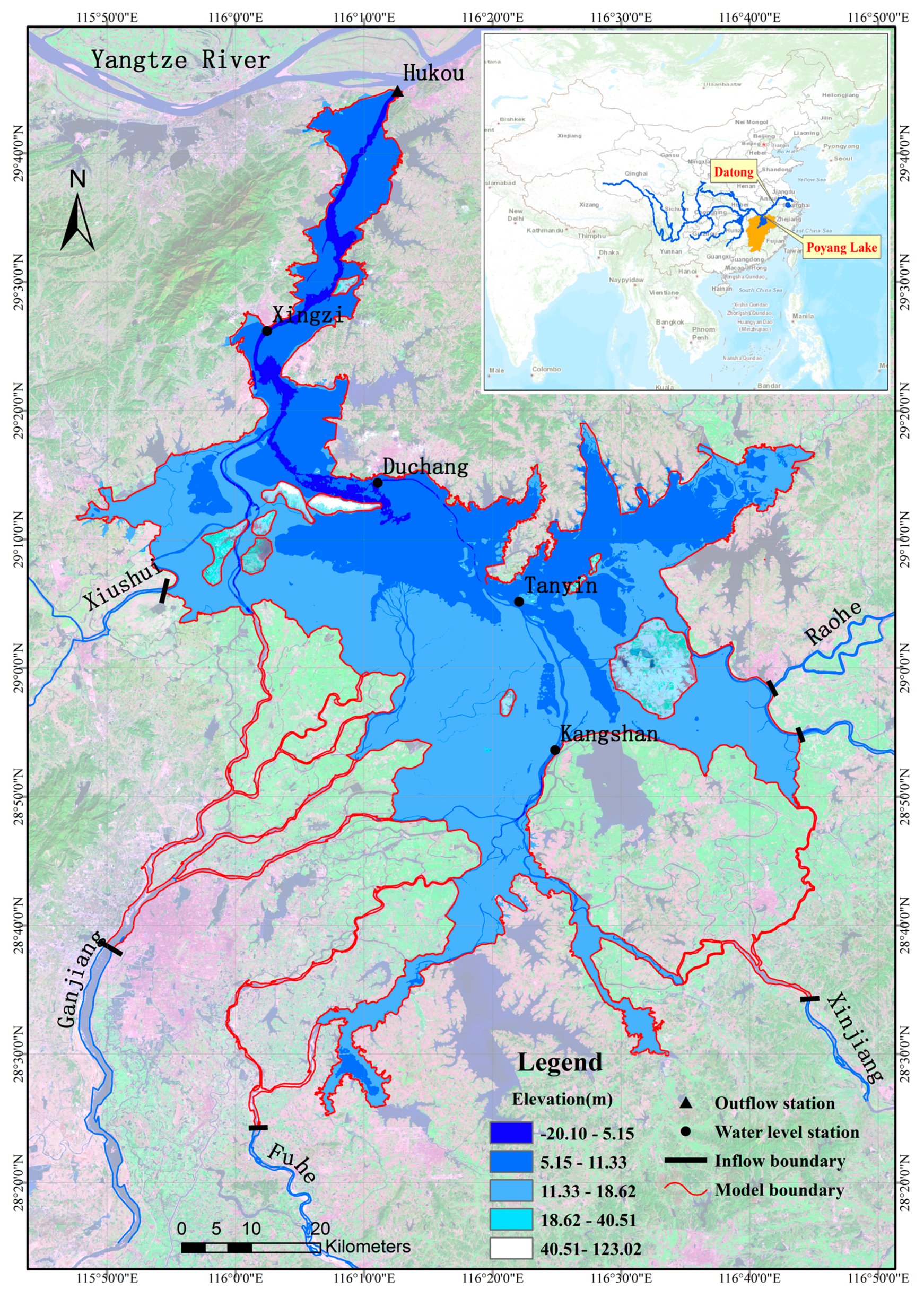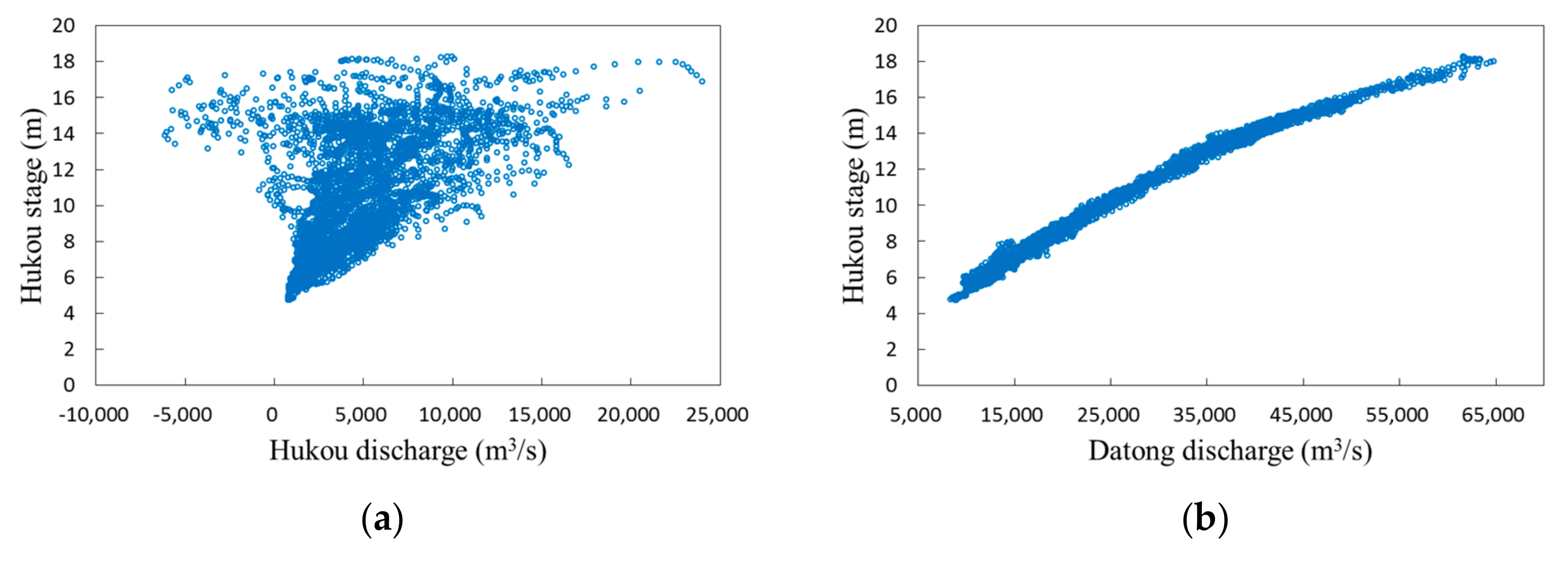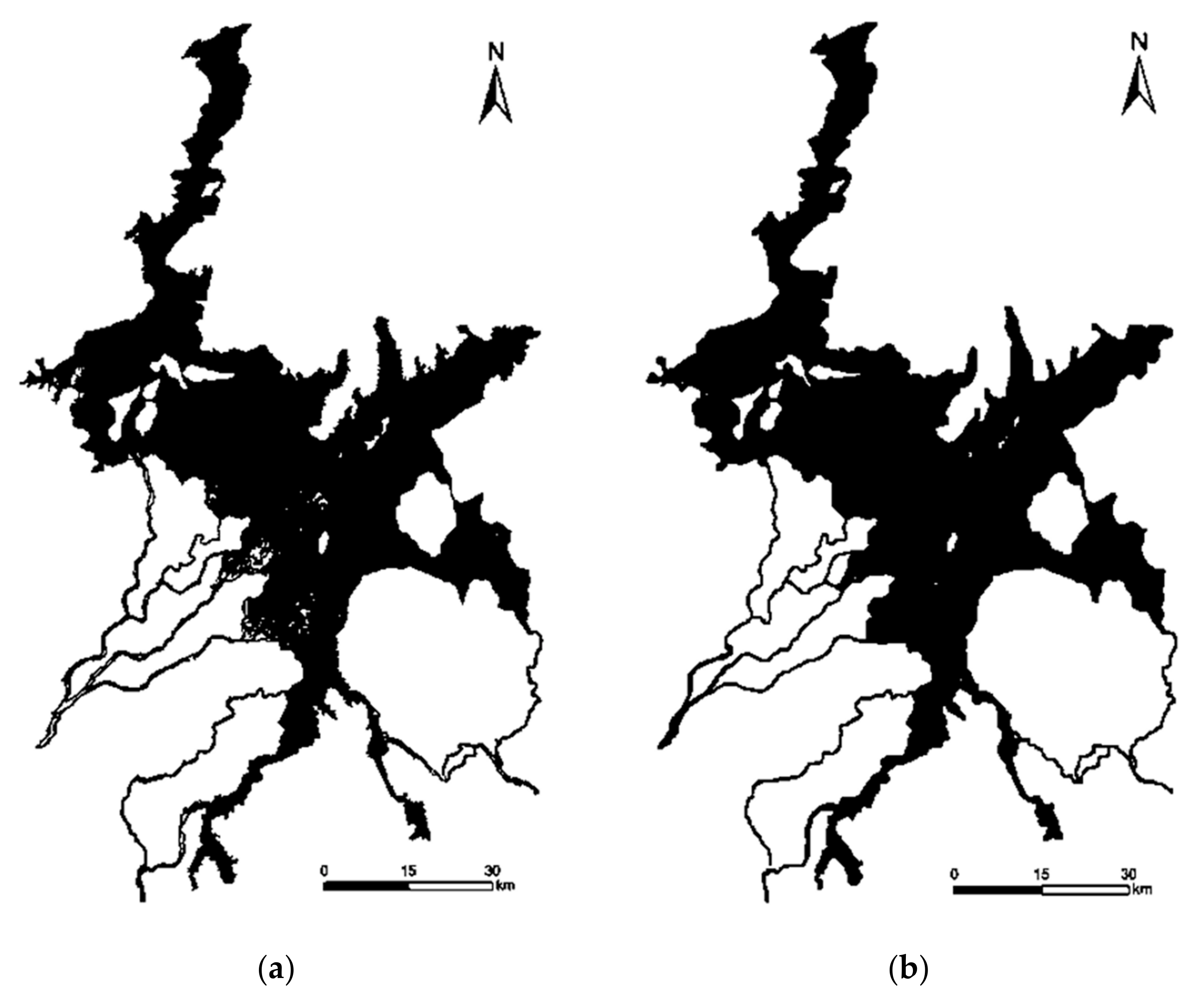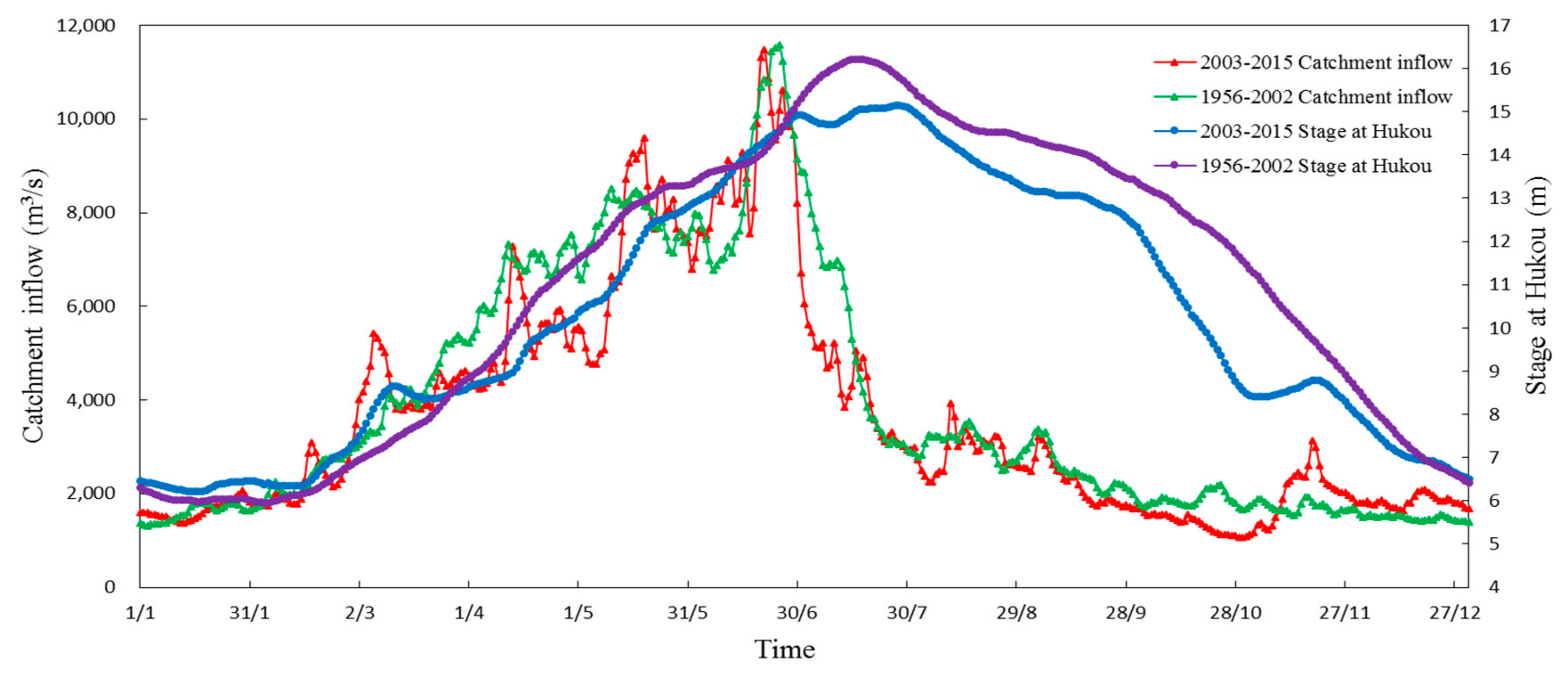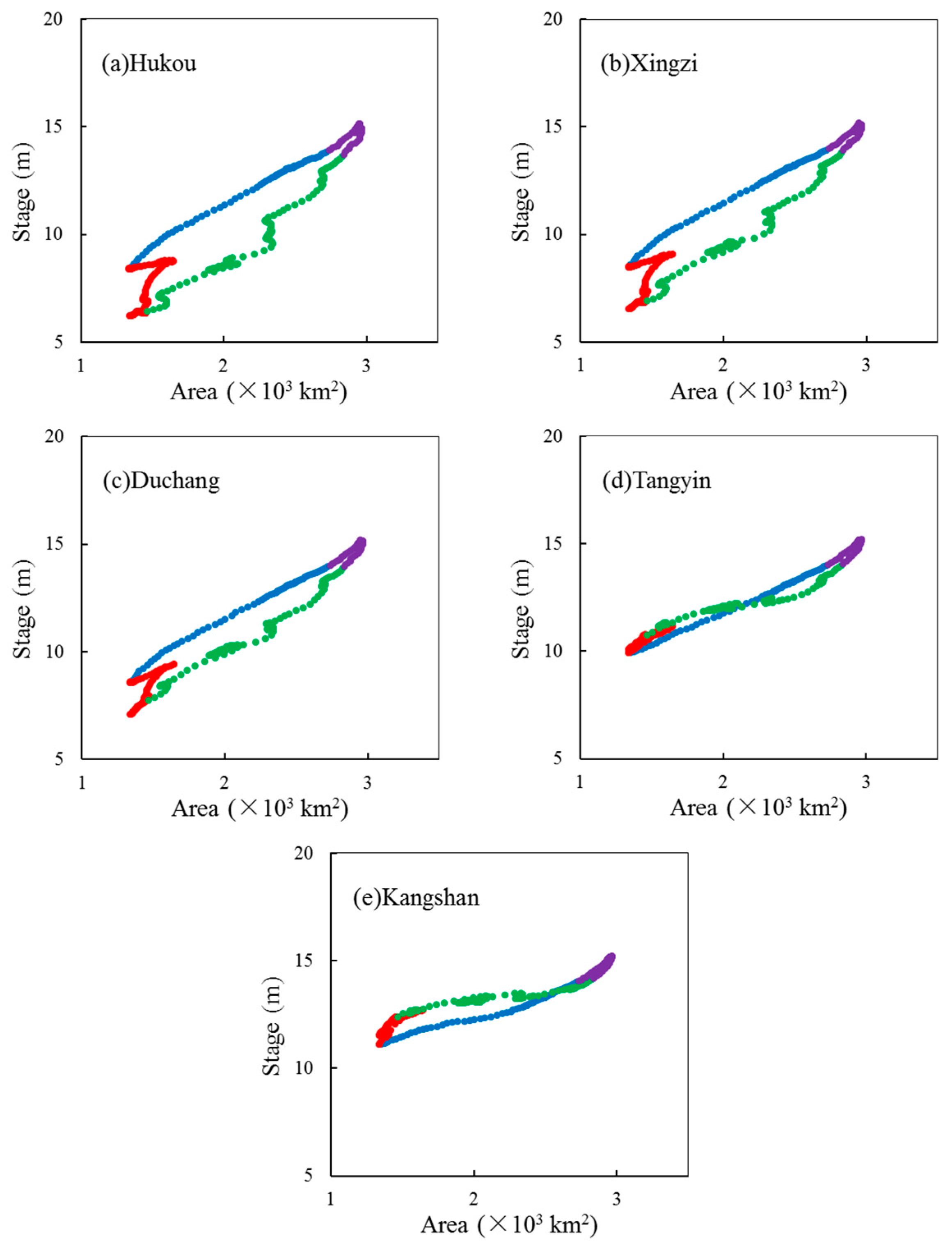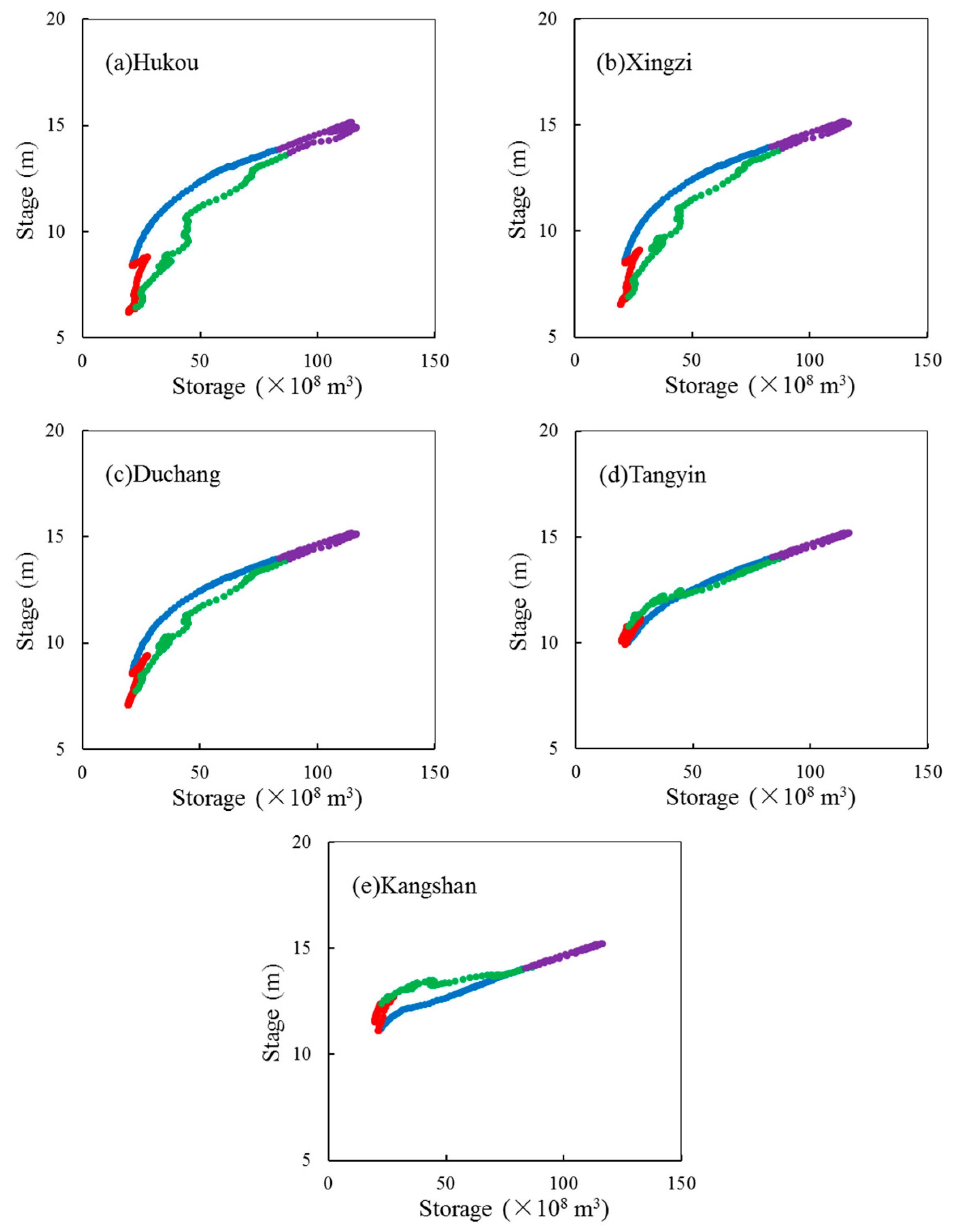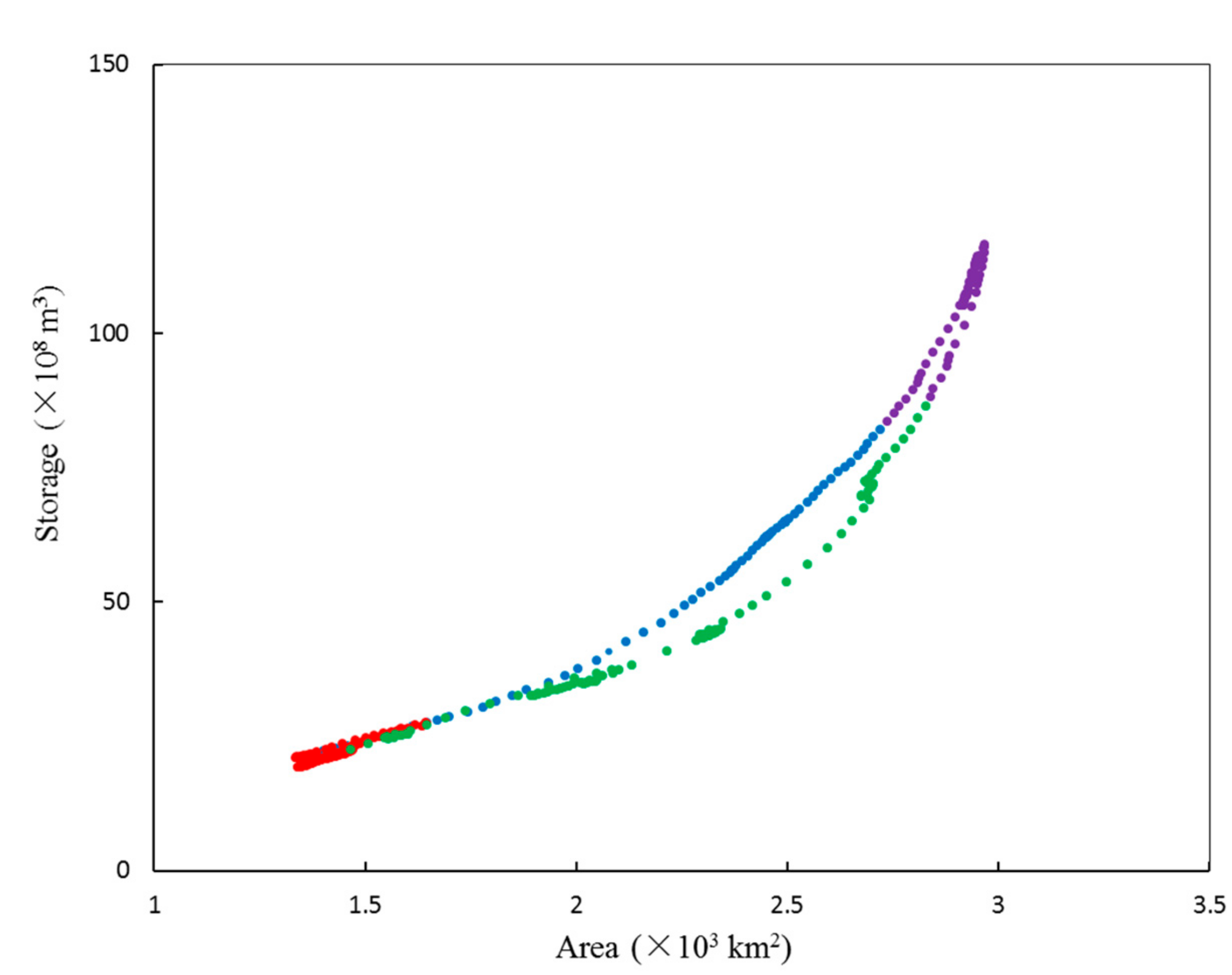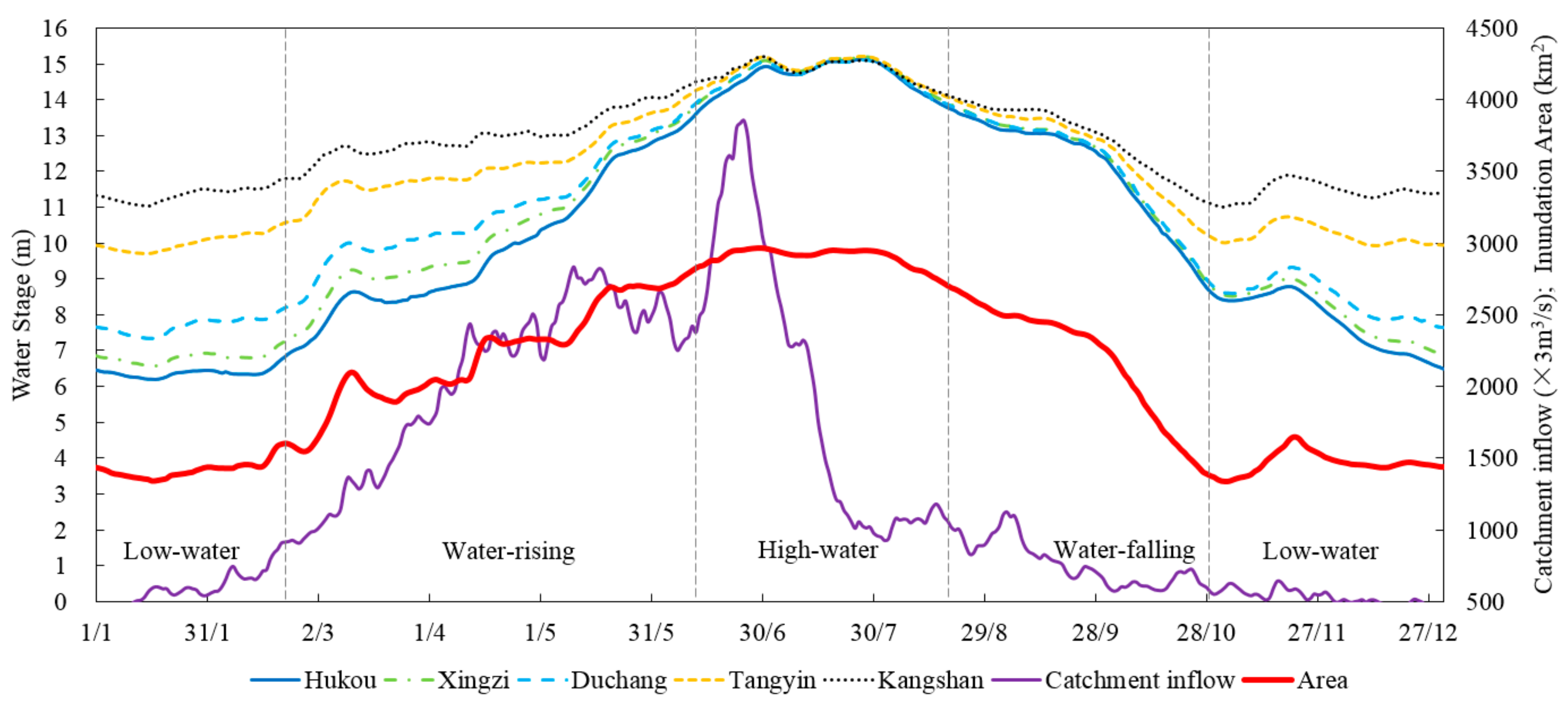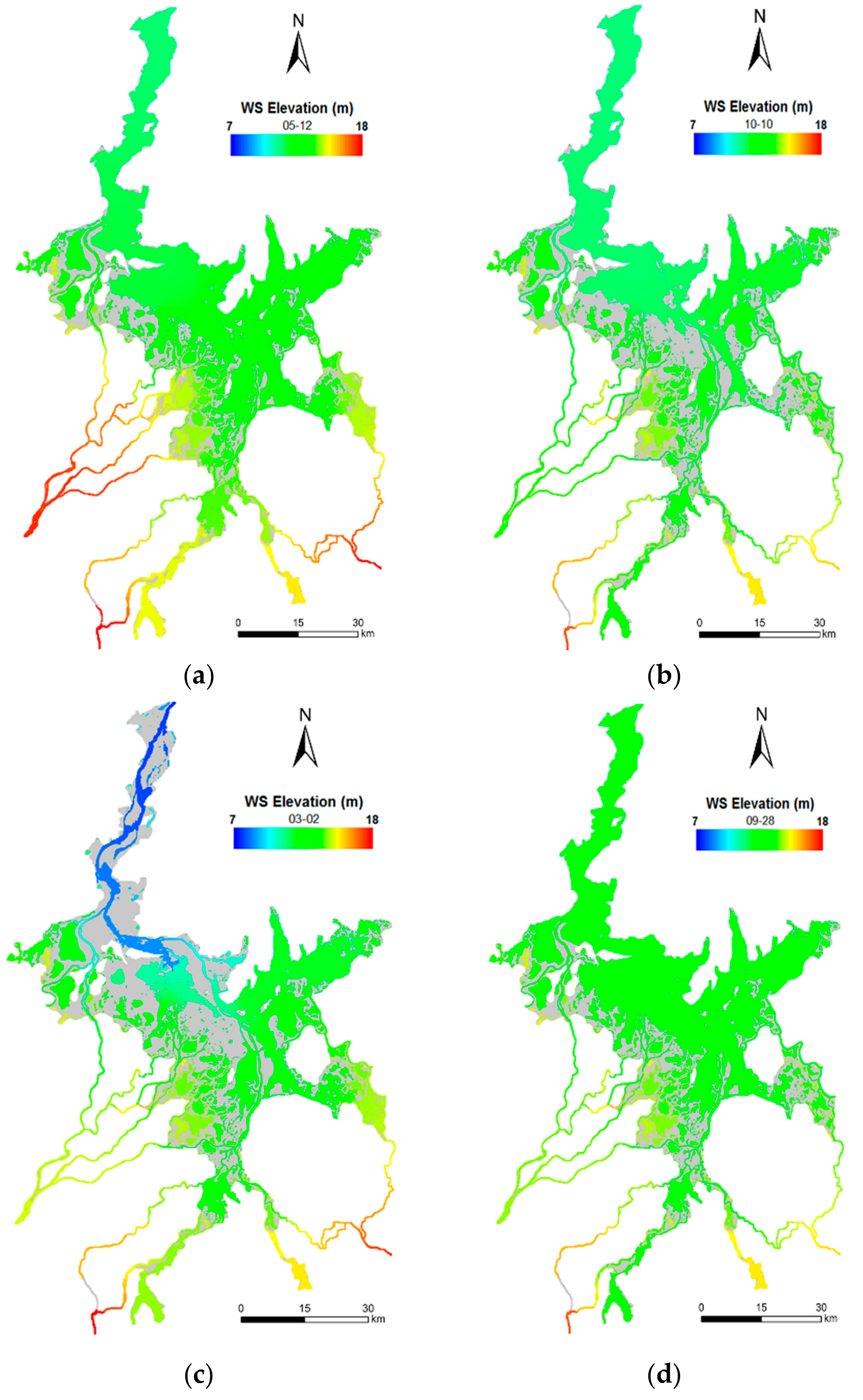1. Introduction
Lake floodplains are vital for ecosystems and humanity, serving as important habitats for wetland biota and providing many services (e.g., flood protection and agriculture and fishing resources) [
1,
2,
3]. As a key indicator used to evaluate a lake’s ecosystem status and evolution, the lake inundation area has attracted much attention [
4,
5]. Over the past several decades, inundation areas of many lakes around the world have undergone pronounced variations or have even vanished as a result of climate change and human activities [
6,
7,
8]. For example, the number of lakes in the Mongolian Plateau with a water surface area of greater than 1 km
2 dropped dramatically from 785 in the late 1980s to 577 in 2010 [
9]. The water area–stage curve determined by lake hydrodynamic processes is central to the study of inundation areas and is widely used for water management, as areas can be estimated by stage, which is a more accessible method [
10].
The area–stage curve does not always demonstrate the presence of single-valued relationships. In some lakes, hysteretic phenomena can be observed, i.e., a given stage value may correspond to different area values. Rudorff et al. simulated the flood dynamics of the lower Amazon floodplain, observing that inundation areas are smaller during the water-rising period than during the water-falling period for the same water level [
11]. Ogilvie et al. adopted Moderate Resolution Imaging Spectroradiometer (MODIS) optical data to research the spatiotemporal dynamics of the Niger Inner Delta flood [
3]. In their study, water area–stage relationships were refined by accounting for hysteresis behavior. Hysteretic phenomena are often found in hydrology relationships [
12] (e.g., runoff connectivity streamflow, discharge, and runoff storage). Phillips et al. found hysteresis between runoff connectivity and streamflow in the Baker Creek Research Basin [
13]. Wolfs et al. used three approaches to develop discharge–stage curves affected by hysteresis [
14]. The corresponding results show that all of the methods used are superior to the traditional rating curve, and that the model tree method is the best because it is easy to understand and generates accurate outputs. Sproles et al. analyzed a number of hysteresis loops of runoff and water storage and found that loops are controlled by the terrain, weather, and geology of a drainage basin [
15].
Influencing factors and inner mechanisms of hysteresis found between water areas and stages have not been systematically and thoroughly analyzed in previous studies. Fortunately, as another feature of highly non-linear hydrologic systems of lake floodplains, research on hysteresis found between discharge levels and stages has been precise and long-standing and may provide a reference. Factors affecting stage–discharge relationships proposed by Boyer [
16] are as follows: (1) the unsteadiness of river flows, which alter the slope of the water surface; (2) backwater effects that change downstream environments; (3) vegetation that affects bed roughness levels; (4) bed evolution as a result of dredging or sediment transport, etc.
As an important wetland in the world, Poyang Lake includes extensive floodplains that support numerous vegetation species, aquatic organisms, and birds. Poyang Lake is a shallow and water-carrying seasonal lake, and catchment inflows and water levels observed at the Hukou station along the Yangtze River undergo significant fluctuations. Complex hydrological behaviors controlled by the combined effects of hydraulic interactions between upstream watershed runoff and the downstream Yangtze River and the complex topography of the lake basin bring about sizable seasonal and annual variations in lake water stages, areas, and storage capacities [
5,
17,
18]. A number of researchers have studied area variations [
19,
20,
21] and water area–stage relationships [
22]. Feng et al. found that Poyang Lake encountered significant seasonal and annual variations from 2000 to 2010 as a result of changes in watershed precipitation [
23]. Mei et al. estimated the daily Emergent Wetland Area and found a rapid increase in average annual conditions from 2003 as a result of seasonal drought occurring in October [
24]. In addition, since the operation of the Three Gorges Dam (TGD), the wetland exposure period has occurred nearly one month sooner than before. Chen et al. analyzed the relationship between annual minimum water level and corresponding area based on data for 2000 to 2006 [
22]. They found that the relationship could be expressed approximately by a linear equation. Li et al. established a single-valued regression equation for the flooded area and stage that was then employed to estimate lake areas for a long-term period of 1961 to 2010 [
10].
In summary, previous inundation area studies have shown that Poyang Lake has undergone significant variations in past decades and single-valued empirical formulas of areas and stages have been developed. The hysteresis of the area–stage curve has not been sufficiently reported, though it is significant for Poyang Lake. The latest study conducted on the hysteresis of Poyang Lake was conducted by Zhang et al. They used daily average hydrologic conditions for 1959–2000 and found two hysteresis directions (namely, clockwise and counter-clockwise) and concluded that watershed inflows are the main factors that affect hysteresis behavior rather than Yangtze River flows or lake basin roughness levels [
25]. However, the analyses of hysteresis mechanisms (especially the presence of different hysteresis directions) are qualitative and inadequate. Effects of magnitude changes of watershed inflows and Yangtze River flows on hysteresis are not considered. The two aspects above are the critical points to reveal the hysteresis phenomenon of Poyang Lake. On the other hand, the water regime of Poyang Lake has, in recent decades, shown remarkable variation, especially since the operation of TGD from 2003, and the corresponding catchment inflows will continue to change [
26,
27]. How these changes will affect the floodplain extent and hysteresis in the inundation dynamics is not known. Therefore, comprehensive research on the characteristics and influencing factors of hysteresis relationships between water stages and inundation areas is necessary to study the inundation area of Poyang Lake.
Water stage data are typically available for hydrometric stations at a daily resolution, but area data are difficult to acquire. Two methods widely used to obtain flooded area data are satellite remote sensing and numerical model simulations. Several forms of satellite remote sensing exist (e.g., Synthetic Aperture Radar (SAR) [
28], Moderate Resolution Imaging Spectroradiometer (MODIS) [
29], etc.). Numerical simulations are efficient and economical tools that generate enough simulated area data of high spatial and temporal frequency [
30,
31]. In this study, a two-dimensional Environmental Fluid Dynamics Code (EFDC) model is used while accounting for the need for area data of a high temporal resolution. The aim of this paper is to study hysteresis relationships of the inundation area–storage–stage for Poyang Lake. To accomplish this, seven simulation scenarios based on the EFDC model are established, accounting for different upstream catchment inflows and downstream water level conditions. The specific objectives of this study are to: (1) reveal the spatiotemporal traits of hysteresis behaviors; and (2) discern the main factors that influence hysteresis and explore influence rules. Our research results reveal inherent connections of the area storage stage, extend knowledge of large floodplain hydrology, and can facilitate the future water management of Poyang Lake and other similar lake floodplains.
4. Discussion
As noted above, area–storage–stage relationships of Poyang Lake show significant hysteretic traits mainly found between the water-rising and water-falling periods. To explore this further, seasonal variations in water stages and lake area are discussed.
Figure 9 shows daily data for catchment inflow, area, and water levels observed at the five stations. During the low-water period, the water stage and area changed slightly and remained at relatively low levels with mean values of 8.860 m and 1440.202 km
2, respectively. Water was confined to long and narrow channels and to internal lakes, including lakes in the southwest separated from open water and lakes in the northeast weakly connected to open water through channels. During the high-water period, due to the inhibiting effects of the Yangtze River, the water stage and area showed high values. Water level differences observed between the five stations were very minor, showing that, in terms of hydrological characteristics, Poyang Lake covered a relatively stabilized large area. Therefore, hysteresis levels were low during the low-water and high-water periods. With catchment precipitation occurring in March, water flowed to the bottomland, and water exchange between the bottomland and channel was frequent and complex. Consequently, the water level and area underwent remarkable variations with differences between maximum and minimum values reaching 3.961 m and 1360.721 km
2 during the water-rising period. During the water-falling period, water levels began to decline and the lake area of the southern main lake reduced significantly, which, in turn, spurred considerable variations in the lake area. In brief, dramatic variations of lake area and complex patterns of water exchange between bottomland and water channel areas shaped hysteresis development during the water-rising and water-falling periods.
However, what is puzzling is that three hysteresis directions (counter-clockwise, clockwise, and splayed) are observed for Poyang Lake. Regarding area–stage relationships, clockwise hysteresis is reported for river floodplain systems, as some water remains in local low-lying zones during the water-falling period, producing an area larger than that of the water-rising period (e.g., [
11]). With regard to discharge–stage relationships caused by flooding, counter-clockwise hysteresis appears due to an additional surface gradient originating from flooding occurring during the flood rising period [
14]. However, for discharge–stage relationships controlled by backwater effects, different directions can manifest depending on the effects of backwater.
For Poyang Lake, three hysteresis directions and different hysteresis magnitudes are observed because the surface gradient observed during the water-rising period is greater than that of the water-falling period (
Figure 9) due to flood fluctuations resulting from catchment inflows and backwater effects of the Yangtze River. During the low-water period, the surface gradient is very large, which can be observed from water level differences found between the stations (
Figure 9). With the onset of the water-rising period, large volumes of upstream catchment water flow into the lake from the south. On the other hand, the Hukou stage begins to become more pronounced due to enhanced Yangtze River flows. Consequently, water stages gradually rise while surface gradients dwindle but remain at relatively high levels. During the water-falling period, the lake begins to drain, as catchment inflows decline with less rainfall while Yangtze River flows also decline. The drainage direction is oriented from south to north through the long and narrow water channel, and water finally drains from the lake into the Yangtze River via the outlet of the Hukou section, which is roughly 1.5 km wide. This implies that the drainage route may not be sufficiently smoothed.
Table 6 shows relative water stage change rates for the water-rising and water-falling periods. It is evident that differences in water level change rates observed at the five stations are less significant during the water-falling periods, revealing a smaller surface gradient for the lake. Hence, counter-clockwise hysteresis occurs at the Hukou station, as corresponding water stages observed at other stations are more significant for the same water stages for Hukou during the water-rising period, resulting in the formation of a larger lake area than that of the water-falling period (
Figure 10). In the same way, counter-clockwise hysteresis occurs at the Xingzi and Duchang stations. Conversely, for a given water stage observed at the Kangshan station, water stages observed at other stations are less significant during the water-rising period than during the water-falling period, causing the area–stage curve to invert (
Figure 10). As the transitional station is located in the center of the lake, the hysteresis direction for the Tangyin station is splayed.
As the two main factors that influence hysteresis, influencing patterns of catchment inflows and Hukou stages are not the same. When catchment inflows increase during the water-rising period, more water flows into the lake from the southern area of Poyang Lake. Water levels observed from the southern stations increase and amplification levels become greater than those of the water-falling period. On the other hand, the Hukou station, which is governed by the Yangtze River, remains unchanged. Hence, the difference in surface gradients between the water-rising and water-falling periods increases, resulting in stronger patterns of hysteresis. Regarding the magnitude change of the Hukou stage, the effect is adverse. Relative to that for 1956–2002, the Hukou stage for 2003–2015 undergoes an obvious decline, mainly as a result of bed downcutting occurring along the main channel of the Yangtze River and along the northern water channel of Poyang Lake. If water levels at the Hukou station continue to reduce—for example, under the condition of S7—the flooded area will decrease accordingly and the hysteresis of Poyang Lake will become more pronounced in the future according to the effect rules listed above. The annual averaged area for S7 will decrease by 11% compared with S1. During the period of June to August, the decrease in the average area, which is an important piece of information for flood hazard research, is up to 16%, with an absolute change of 461.622 km2. The hysteresis will become larger, which means that the estimation of the water area will produce a larger error if the hysteresis is ignored. These analyses may provide useful guidance to water management, for example, managing flood hazards.
5. Conclusions
Through a quantitative analysis of area–stage relationships based on the EFDC model, the hysteresis behaviors of Poyang Lake were revealed. The results show that hysteresis levels are significant and should spur further research on inundation hydrodynamics. Maximum calculation error values of up to 25% can result when estimating a lake area from a conventional single-valued function of areas and Xingzi stages without considering hysteresis effects, as other researchers have done. Characteristics of hysteresis are complex and present obvious spatial differences. Three hysteresis directions (counter-clockwise, clockwise, and splayed loop) were observed at different stations, and these are reported for the first time for Poyang Lake. From the combined function of watershed inflows and Yangtze River flows, water surface gradients observed during the water-rising period are greater than those of the water-falling period. This explains the different hysteresis directions and magnitudes observed for the Hukou station, which is located at the northernmost point and which shows the largest values, while the Tangyin station is located in the center of the lake and presents the smallest values. Therefore, functions between areas and stages during water-rising and water-falling periods should be established, respectively, in the research of area–stage relationships and management of flood protection and water withdrawal. If the hysteresis is not considered when estimating the lake area from the water stage in the water management of Poyang Lake, Tangyin station (not the conventional Xingzi station) should be chosen as the water stage station due to its weak hysteresis.
Catchment inflows and Yangtze River flows reflected by the Hukou stage are the main factors that influence the hysteresis of Poyang Lake due to its particular hydrological regime and complex topography. Temporal fluctuations in catchment inflows and of the Hukou stage have strong positive effects on hysteresis development. The effects of magnitude changes in catchment inflows and of Hukou stages on hysteresis were found to be adverse. For the Hukou stage, a smaller magnitude produces stronger hysteresis behavior by aggravating the difference between surface gradients observed during the water-rising and water-falling periods. With the continuing dramatic evolution of the hydrological regimes of Poyang Lake and the Yangtze River, research conclusions on the decline of the Hukou stage may reveal pronounced hysteresis trends, which can guide the future water management of Poyang Lake. This paper analyses characteristics, influencing factors and mechanisms of hysteresis for Poyang Lake, enhances the calculation accuracy of area estimations based on water stages, and furthers understanding of hydrodynamic behaviors observed in large lake floodplain systems.
